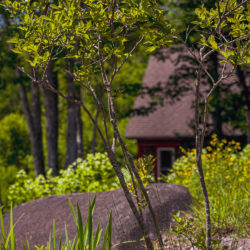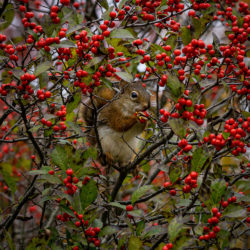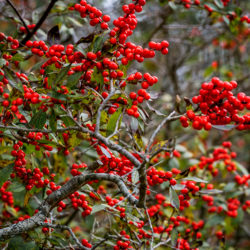Etymology
Ilex is Latin for a plant with evergreen leaves; verticillata is Latin for whorled, due to the appearance of the berry arrangements.
Native Habitat
Wetland margins, and shores of lakes and swamps.
Garden Uses
Especially beautiful in late autumn through winter due to the bright red berries. Excellent choice in bird or rain gardens. Very adaptable to wet or dry areas, and from full sun to shade. Flowers appear on new growth, so pruning to shape should be done in very early spring before new growth emerges.
Overview
Globular, upright, medium-sized, deciduous shrub or small tree, typically 6-10 feet tall and wide, but up to 20 feet tall in optimal settings, where it often suckers to form dense thickets. It tolerates acidic habitats, in sun to shade. Generally, these shrubs are male or female (unisexual, dioecious), and both are required for pollination (1:10+).
Leaves and Stems
Leaves are simple, alternate, deciduous, ovoid, 2 to 3 inches long, toothed, and lacking the sharp points of many hollies. One leaf grows from each node, on a hairy stalk 1/4-inch long (petiole). In summer, the upper surface is deeper green, and the under surface is paler. Both surfaces may be hairy. Leaves can turn maroon in autumn but they are very sensitive to cold, immediately turning black and shriveling at first frost. Leaves set later than many species in the spring. Branching stems are erect, woody and brown to gray at maturity, with several growing from a single base unless pruned. Bark is thin and smooth.
Flowers
Inconspicuous, small greenish-white flowers, with 5 to 8 flexed petals, appear in the leaf axils on both female and male plants in June to July.
Fruit/Seed
Dense clusters of bright red to orange berries, approximately 1/4 inch in diameter, on female plants only. Each berry contains 1 to several brown nutlets. Berries remain on the stems throughout the winter if not harvested by wildlife.
Animal Associates
Plants provide nesting and cover sites, due to foliage density, as well as attractive flowers for pollinators such as honey bees. Larval host for some butterflies. Berries are important cold weather food for birds and small mammals.
Propagation
Seeds can be germinated post-collection, or by cold stratification, but may take years to germinate in moist soil; one suggested strategy is up to 60 days at 68-86 degrees F, followed by 60-90 days at 41 degrees F, and then keep warm and moist until sprouts emerge.
Ethnobotanical Uses
Winterberry is considered toxic, and should not be ingested by humans.
Garden Location
Library Garden (see garden map)
Sources
Lady Bird Johnson Wildflower Center
Plant Profile by Kate O’Dell





